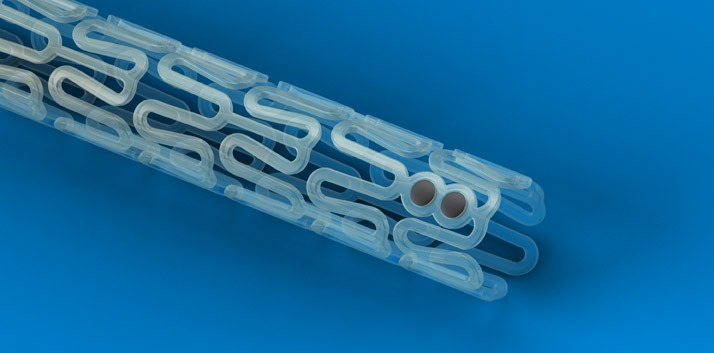
Twelve-month follow-up of the everolimus-eluting, Absorb bioresorbable vascular scaffold (Abbott Vascular) below the knee has demonstrated “excellent safety, patency, and freedom from target lesion revascularisation,” in the treatment of focal tibial and distal popliteal lesions, according to a paper published in JACC: Cardiovascular Interventions.
Though effective for the treatment of atherosclerotic peripheral artery disease, metallic stents can have several detrimental effects on the vessel wall, including the permanent prevention of vasomotion, autoregulation, and adaptive remodelling. Furthermore, there is a recognised risk for late target vessel failure that may result from incomplete endothelialisation, stent fracture, or malapposition. Though it has similar mechanical scaffolding and antiproliferative properties to current-generation drug-eluting stents, the authors of this study—led by Ramon Varcoe, Prince of Wales Hospital, Sydney, Australia—write that “following revascularisation and vessel wall stabilisation, [the Absorb scaffold] is resorbed by the body through the inert process of hydrolysis. The resorbable nature of the device gives it significant potential for positive blood vessel wall remodelling, stabilisation of the atheromatous plaque, and return of contractile function, a new paradigm of vascular restorative therapy.”

Between September 2013 and November 2015, 33 patients (18 men; mean age 81.8±7.9 years) meeting the inclusion criteria were included in the single-centre study. In these patients, 38 limbs were treated for critical limb ischaemia (68.4%) or severe claudication (31.6%). Fifty scaffolds were used to treat a total of 43 lesions, with a mean length of 19.2±1.6mm. Technical success was achieved in all patients with no amputation, death, or target limb bypass surgery within 30 days of the procedure. One patient underwent clinically-driven target lesion revascularisation (TLR) on the second day following the procedure due to ischaemic symptoms. The authors note that this event “was thought to have occurred because the patient had been taken off warfarin prior to the index procedure and no antiplatelet therapy had been commenced”. The other adverse events were three (7.9%) femoral pseudoaneurysms.
During a mean follow-up period of 12±3.9 months, five patients died and all others were available for follow-up. Among the 38 treated limbs, clinical improvement was present in 30 (79%). Binary restenosis was detected in three of 50 scaffolds (6%). Using the Kaplan-Meier method, rates of primary patency were 96% and 84.6% at 12 and 24 months, respectively, and rates of freedom from clinically-driven TLR were 96% and 96% at 12 and 24 months, respectively. Complete wound healing occurred in 64% of those treated for tissue loss, with no major amputation and a limb-salvage rate of 100%.
Varcoe et al write that the rates of freedom from binary restenosis and clinically-driven TLR of 96% at 12 months represent “promising early results in the interventional practice of below-the-knee arteries,” results that “suggest [the Absorb scaffold] has significant potential to become the favoured class of therapy in this group of patients.”
“Our results suggest that the bioresorbable scaffold may at least offer patency equivalence [to drug-eluting stents] while maintaining advantages related to its dissolution,” the authors write. “This may allay some fears that drug-eluting stents, which provide an effective mechanical scaffold and drug delivery vehicle, might also act as a barrier to future reintervention in an area that has been plagued by poor durability and the need for frequent reintervention.”
Varcoe told Vascular News, “Lower limb amputation takes a huge toll on society and is often underappreciated by our community. We have been striving to eliminate amputation from our practice by exploring novel technologies that can be used to revascularise the ischaemic limb. Our experience using the Absorb bioresorbable scaffold to treat blocked leg arteries has demonstrated results at least as good as the best drug-eluting metal stents with several inherent advantages. The scaffold disappears over time, eliminating the irritant effect of the permanent metallic implant, but even better, it seems to facilitate a restoration of normal function with return of blood vessel contractility. Most interventionalists are trying to avoid implanting permanent metallic implants but we still frequently need scaffolding to overcome elastic recoil and treat dissection. This device may offer the best of both worlds.”













